1.2 PREFACE
“Stories are good for us, whether we hear them, read them, write them, or simply imagine them. But stories that we read are particularly good for us. In fact I believe they are essential.”
Frank Smith, Reading: FAQ
FROM PAUL AND ROBIN More than a decade ago, when we began writing the first edition of this textbook, we had many small ideas: particular aspects of economics that we believed weren’t covered the right way in existing textbooks. But we also had one big idea: the belief that an economics textbook could and should be built around narratives, that it should never lose sight of the fact that economics is, in the end, a set of stories about what people do.
Many of the stories economists tell take the form of models—
Those stories have been integrated into every edition, including this one, which contains more stories than our earlier editions. Once again, you’ll find them in the chapter opening stories, in boxed features like Economics in Action, For Inquiring Minds, and Global Comparisons, but now in our new Business Cases as well.
As in the previous edition, we’ve made extensive changes and updates in coverage to reflect current events—
We have also expanded our coverage of business issues, both because business experience is a key source of economic lessons and because most students will eventually find themselves working in the business world. We are especially pleased with how the new Business Cases have turned out and how they augment the overall number and richness of our stories.
As you’ll see, there’s a great deal of new material, and there are some significant changes (and, we hope, improvements) in pedagogy. But we’ve tried to keep the spirit the same. This is a book about economics as the study of what people do and how they interact, a study very much informed by real-
FROM IRIS AND JACK When we were approached about the possibility of adapting the latest edition of Paul and Robin’s wonderful book for the Canadian market we were incredibly excited. The U.S. edition of the text, which started out as a top-
We believe the narratives approach adopted by Paul and Robin is an excellent way to expose students to the beauty of economics and its power to explain and understand the world we all live in.
Many of the narratives contained in the chapter opening stories, Economics in Action, For Inquiring Minds, Global Comparisons, and Business Cases have been altered, sometimes significantly, so as to infuse them with content relevant to Canadians. Of course Canadians, living in an open economy that is quite dependent on trade, are used to thinking about global economic issues and linkages. With that in mind a few of the narratives have not changed much from what appeared in the third U.S. edition. Throughout we have taken great care whenever altering the text so as to maintain the quality of the underlying narratives.
Chapters 14 and 15, the two chapters that deal with money, banking, the central banking system, and monetary policy have been almost entirely rewritten so as to properly cover this material from the Canadian perspective. Of course discussion of other government policies, such as fiscal and trade policy, and other facets of the economy have also been given a Canadian treatment as well.
We are extremely pleased to be able to do our part to bring these narratives to a Canadian audience. If, after reading this text, some students decide that economics is really interesting and go on to take additional economics courses, we would be happy. But most importantly, we hope that all students feel this text greatly enhances and assists their study of economics.
What’s New
Although the second U.S. edition was a resounding success, further establishing Macroeconomics as one of the bestselling macroeconomics textbooks in the United States, we learn with each new edition that there is always room for improvement. So, for the second Canadian edition, we undertook each revision with four goals in mind:
To make the book more relevant to a Canadian audience
To expand the book’s appeal to business students
To be as current and cutting edge as possible in the topics covered and the examples included
To make the book more teachable and accessible
We hope that the following revisions lead to a more successful teaching experience for you.
Selected Canadian Examples
Introduction: Opener: Any Given Sunday: Halifax’s Spring Garden Road as an example of the market economy in action.
Chapter 2: Economics in Action: Economists, Beyond the Ivory Tower: Looking at jobs for Canadian economists outside academia.
Chapter 3: Global Comparison: Pay More, Pump Less: Comparing European fuel costs and consumption with those of Canada and the United States.
Chapter 4: Economics in Action: The Lobsters of Atlantic Canada: How quotas control the supply of lobster coming from Atlantic Canada.
Chapter 5: For Inquiring Minds: Softwood Lumber Dispute: A history of the contentious softwood lumber trade between Canada and the United States.
Chapter 5: Economics in Action: Freeing Canada’s Trade with the World: Discussion of the Canada–
Chile Free Trade Agreement and Canada’s current free trade negotiations. Chapter 7: Figure 7-3: Canada’s GDP in 2011: Two Methods of Calculating GDP.
Chapter 8: The Unemployment Rate: Determining various unemployment rates in Canada and comparing them to the real GDP growth rate.
Chapter 9: Business Case: Sources of Canada’s Labour Productivity Growth, 1970–2010: How different Canadian industry sectors have fared since 1970.
Chapter 10: Economics in Action: A Housing Bubble in Vancouver?: A bursting housing bubble in the United States triggered the financial crisis of 2008. Is a similar bubble, with the same potential for crisis, now building in Canada?
Chapter 11: Opener: In Cod We Trusted—
The Cod Fishery in Newfoundland and Labrador: How the moratorium on cod fishing affected the economy of Atlantic Canada. Chapter 12: Economics in Action: Is Stabilization Policy Stabilizing?: How the Bank of Canada has responded to different recessions.
Chapter 13: Business Case: KIP Goes to School: Action Plan Spending on Knowledge Infrastructure: The beneficial effect of Canada’s 2009 Economic Action Plan on educational infrastructure.
Chapter 14: The Evolution of the Canadian Banking System: How our banking system came to be as it is today, including the creation of the Bank of Canada.
Chapter 15: For Inquiring Minds: Eight Fixed Dates for the BOC Policy Interest Rate Announcements: When the Bank of Canada announces its interest rate policy and why these announcements are so important.
Chapter 17: Regulation in the Wake of the Crisis: How the Canadian government changed mortgage regulations after the banking crisis of 2008, which began in the U.S., to reduce the likelihood of such an event happening here.
Chapter 18: Economics in Action: When Did the Business Cycle Begin?: How Canada’s economy changed from predominantly agricultural to industrial.
New Business Cases
Now, more than ever, students entering the business community need a strong understanding of economic principles and their applications to business decisions. To meet this demand, almost every chapter now concludes with a real-
The cases range from the 2009 bankruptcy of General Motors, once the symbol of North American economic success, and its rebound in 2010, to a look at how small businesses in Newfoundland adapted in order to survive during the recent recession, to an examination of the productivity surge in retailing driven by improvements in global logistics at Loblaws and Walmart. They also place the individual consumer and firm in the macroeconomy with examples that illustrate the changing job market during a recession (Workopolis.com and Monster.ca), the role of gift cards in secondary markets (CardSwap.ca), and the value of “breakage” when individual consumers fail to use up their gift cards completely.
Each case is followed by critical thinking questions that prompt students to apply the economics they learned in the chapter to real-
An Emphasis on Currency
The second Canadian edition has been updated to remain the most current textbook on the market in its content, data, and examples.
New Chapter: “Crises and Consequences” This new chapter provides an up-
Economics in Action: A Richer Story to Be Told Students and instructors alike have always championed Macroeconomics for its applications of economic principles, especially our Economics in Action feature. In the second Canadian edition, we have revised or replaced a significant number of Economics in Action applications in every chapter to ensure that the book remains fresh and cutting edge. We believe this provides the richness of content that drives student and instructor interest. All Economics in Action features are listed on the inside cover.
Opening Stories We have always taken great care to ensure that each chapter’s opening story illustrates the key concepts of that chapter in a compelling and accessible way. And, as always, we update most of these in each edition and provide many completely new stories. New openers include the story of Facebook and the huge amounts of funding needed to obtain its large server farms; the story behind Canada’s Economic Action Plan and the reactions to the stimulus; the story of China’s economic rise, surpassing Japan as the world’s second largest economy, and the method economists use to measure such trends; and the story of Mark Carney and his high profile roles, first as Governor of the Bank of Canada, then as Governor of the Bank of England.
A More Teachable and Accessible Presentation
Streamlined Chapters Because less is often more, we’ve streamlined the exposition in a number of places where our desire for thoroughness got a little ahead of our pedagogy. The chapters on fiscal policy and monetary policy, in particular, are a lot smoother in this edition.
A More Focused Treatment of the Keynesian Cross The main coverage of the Keynesian cross in the chapters on aggregate expenditure and AD/AS has been retained, but coverage of the integrated 45-degree diagrams in later chapters on fiscal policy and monetary policy has been cut back. This change was made in response to input from instructors who were vocal in their request for less integrated coverage of the Keynesian cross to make our book more accessible to their students. Keynesian coverage remains as important as ever in these chapters. But the treatment is now more focused and, we hope, free of unnecessary complexity.
A More Visual Exposition The research tells us that students read more online, in shorter bursts, and respond better to visual representations of information than ever before. In the second Canadian edition, we’ve worked hard to present information in the format that best teaches students.
We’ve shortened our paragraphs for easier reading and included numbered and bulleted lists whenever content would allow. You will find helpful new summary tables in this edition. And, most helpful, are the visual displays in the book, including dynamic representations that turn paragraphs of text into a more accessible, and appealing, visual presentation.
Advantages of This Book
Our basic approach to textbook writing remains unchanged:
Chapters build intuition through realistic examples. In every chapter, we use real-
world examples, stories, applications, and case studies to teach the core concepts and motivate student learning. The best way to introduce concepts and reinforce them is through real- world examples; students simply relate more easily to them. Pedagogical features reinforce learning. We’ve crafted a genuinely helpful set of features, our “tools for learning,” that are presented in a visual walkthrough format.
Chapters are accessible and entertaining. We use a fluid and friendly writing style to make concepts accessible and, whenever possible, we use examples that are familiar to students.
Although easy to understand, the book also prepares students for further coursework. There’s no need to choose between two unappealing alternatives: a textbook that is “easy to teach” but leaves major gaps in students’ understanding, or a textbook that is “hard to teach” but adequately prepares students for future coursework. We offer the best of both worlds.
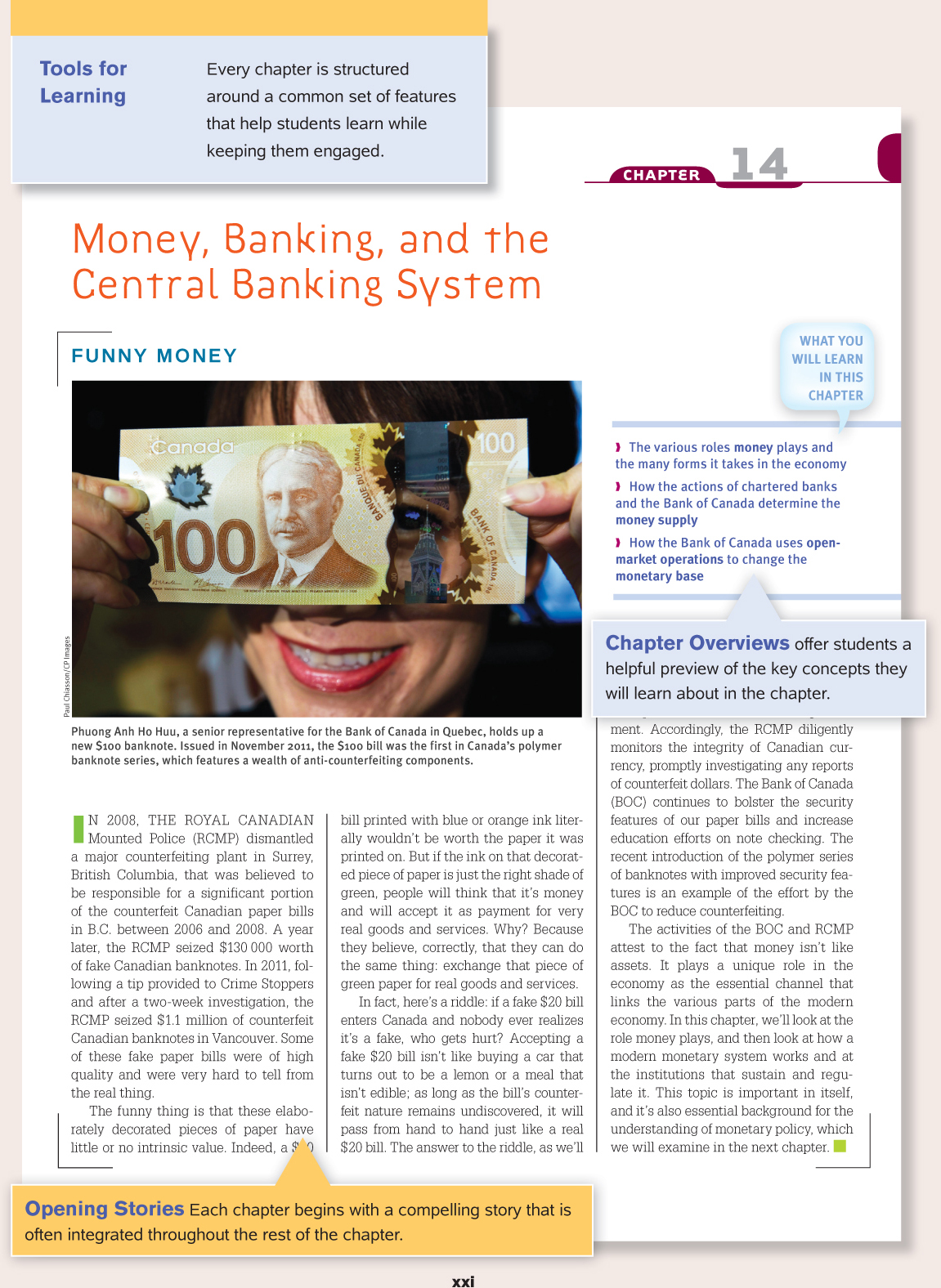
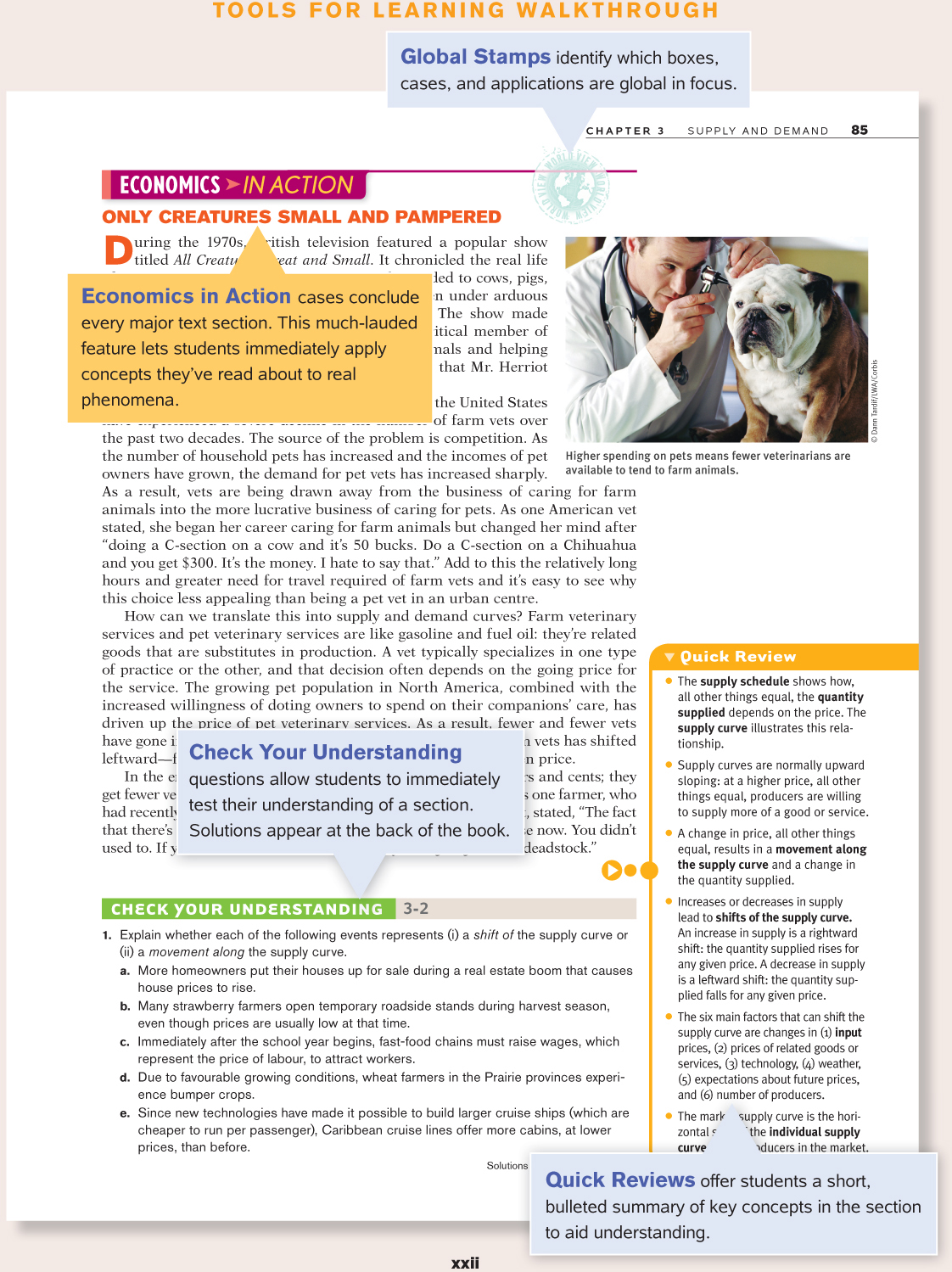
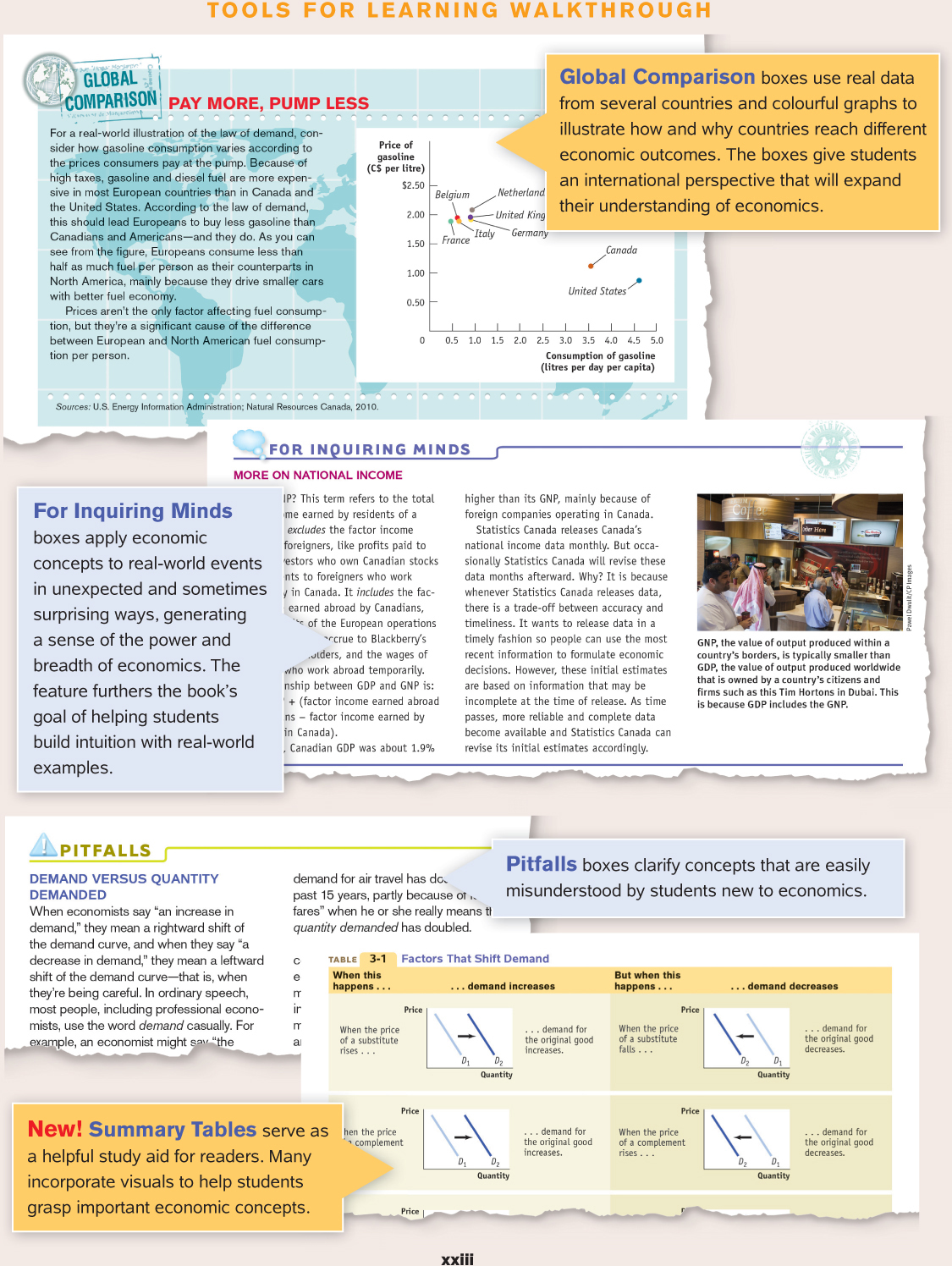
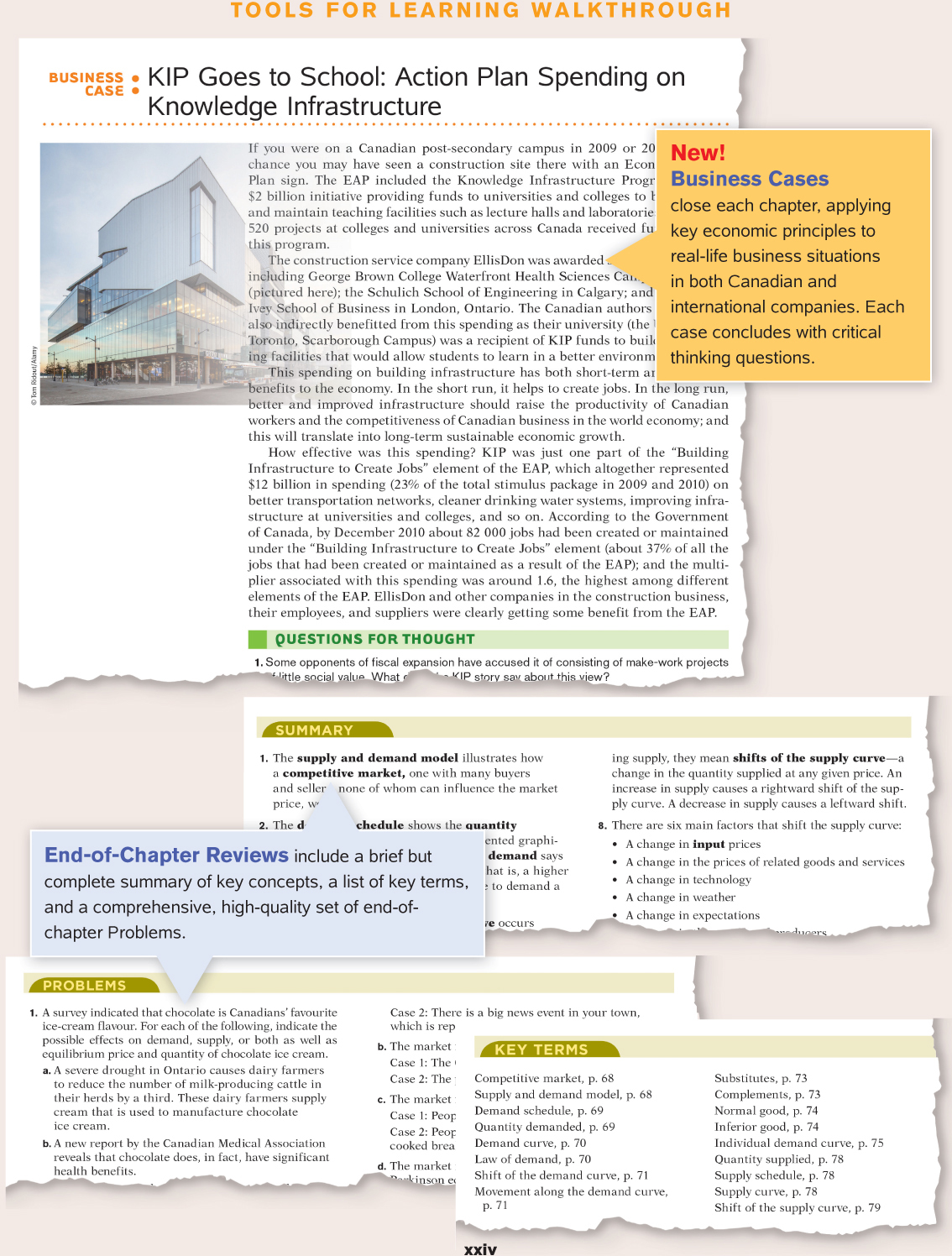
Organization of This Book: What’s Core, What’s Optional
We realize that some of our chapters will be considered optional. Below is a list of what we view as core chapters and those that could be considered optional. We’ve annotated the list of chapters to indicate what they cover should you wish to incorporate them.
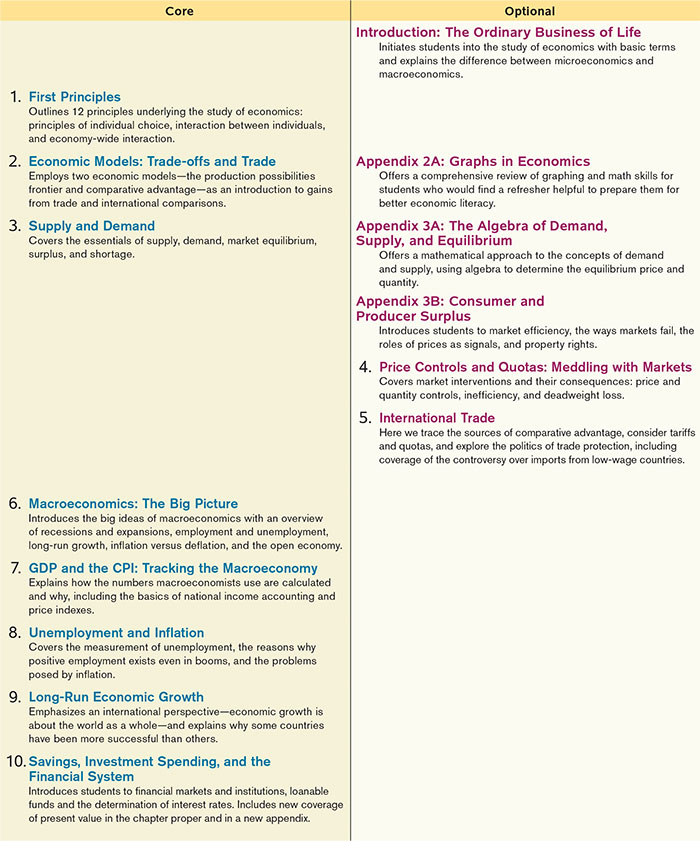

Supplements and Media
Worth Publishers is pleased to offer an enhanced and completely revised supplements and media package to accompany this textbook. The package has been crafted to help instructors teach their principles course and to give students the tools to develop their skills in economics.
For Instructors
Instructor’s Resource Manual with Solutions Manual The Instructor’s Resource Manual is a resource meant to provide materials and tips to enhance the classroom experience. The Instructor’s Resource Manual provides the following:
Chapter-
by- chapter learning objectives Chapter outlines
Teaching tips and ideas that include:
Hints on how to create student interest
Tips on presenting the material in class
Discussion of the examples used in the text, including points to emphasize with your students
Activities that can be conducted in or out of the classroom
Hints for dealing with common misunderstandings that are typical among students
Web resources (includes tips for using EconPortal)
Solutions manual with detailed solutions to all of the end-
of- chapter Problems in the textbook
Printed Test Bank The Test Bank provides a wide range of questions appropriate for assessing your students’ comprehension, interpretation, analysis, and synthesis skills. Totalling over 4500 questions, the Test Bank offers multiple-
The Test Bank features include the following:
To aid instructors in building tests, each question has been categorized according to its general degree of difficulty. The three levels are easy, moderate, and difficult.
Easy questions require students to recognize concepts and definitions. These are questions that can be answered by direct reference to the textbook.
Moderate questions require some analysis on the student’s part.
Difficult questions usually require more detailed analysis by the student.
Each question has also been categorized according to a skill descriptor. These include Fact-
Based, Definitional, Concept- Based, Critical Thinking, and Analytical Thinking. Fact-
Based Questions require students to identify facts presented in the text. Definitional Questions require students to define an economic term or concept.
Concept-
Based Questions require a straightforward knowledge of basic concepts. Critical Thinking Questions require the student to apply a concept to a particular situation.
Analytical Thinking Questions require another level of analysis to answer the question. Students must be able to apply a concept and use this knowledge for further analysis of a situation or scenario.
To further aid instructors in building tests, each question is conveniently cross-
referenced to the appropriate topic heading in the textbook. Questions are presented in the order in which concepts are presented in the text. The Test Bank includes questions with tables that students must analyze to solve for numerical answers. It also contains questions based on the graphs that appear in the book. These questions ask students to use the graphical models developed in the textbook and to interpret the information presented in the graph. Selected questions are paired with scenarios to reinforce comprehension.
Computerized Test Bank The printed Test Bank is available in CD-
Lecture PowerPoint Presentation The enhanced PowerPoint presentation slides are designed to assist you with lecture preparation and presentations. The slides are organized by topic and contain graphs, data tables, and bulleted lists of key concepts suitable for lecture presentation. Key figures from the text are replicated and animated to demonstrate how they build. The slides have been designed to allow for easy editing of graphs and text. These slides can be customized to suit your individual needs by adding your own data, questions, and lecture notes.
CoursePacks Plug our content into your course management system. Whatever you teach, or whether you use Blackboard, WebCT, Desire2Learn, Angel, Sakai, or Moodle to manage your course, we have free content and support available. Registered instructors can download cartridges with no hassle and no strings attached. Content includes our most popular free resources and book-
Further Resources Offered
![]()
www.saplinglearning.com
Sapling Learning provides the most effective interactive homework and instruction that improves student-
Sapling Learning offers an enjoyable teaching and effective learning experience that is distinctive in three important ways:
Ease of Use: Sapling Learning’s easy-
to- use interface keeps students engaged in problem- solving, not struggling with the software. Targeted Instructional Content: Sapling Learning increases student engagement and comprehension by delivering immediate feedback and targeted instructional content.
Unsurpassed Service and Support: Sapling Learning makes teaching more enjoyable by providing a dedicated Masters-
or PhD- level colleague to service instructors’ unique needs throughout the course, including content customization.
CourseSmart eBooks http:/
CourseSmart eBooks offer the complete book in PDF format. Students can save money, up to 60% off the price of print textbooks. With the CourseSmart eBook, students have the ability to take notes, highlight, print pages, and more. A great alternative to renting print textbooks!
Worth Noting Worth Noting keeps you connected to your textbook authors in real time. Whether they were just on CNBC or published in the New York Times, this is the place to find out about it. Visit Worth Noting at http:/
i>clicker Developed by a team of University of Illinois physicists, i>clicker is the most flexible and reliable classroom response system available. It is the only solution created for educators, by educators—
Acknowledgments
Our deep appreciation and heartfelt thanks to the following reviewers, class-
Carlos Aguilar, El Paso Community College
Seemi Ahmad, Dutchess Community College
Farhad Ameen, Westchester Community College
Dean Baim, Pepperdine University
David Barber, Quinnipiac College
Janis Barry-
Hamid Bastin, Shippensburg University
Michael Bonnal, University of Tennessee, Chattanooga
Milicia Bookman, Saint Joseph’s University
Anne Bresnock, California State Polytechnic University, Pomona
Colleen Callahan, American University
Giuliana Campanelli Andreopoulos, William Patterson University
Charles Campbell, Mississippi State University
Randall Campbell, Mississippi State University
Joel Carton, Florida International University
Andrew Cassey, Washington State University
Sanjukta Chaudhuri, University of Wisconsin, Eau Claire
Eric Chiang, Florida Atlantic University
Abdur Chowdhury, Marquette University
Chad Cotti, University of Wisconsin, Oshkosh
Maria DaCosta, University of Wisconsin, Eau Claire
James P. D’Angelo, University of Cincinnati
Orgul Demet Ozturk, University of South Carolina
Harold Elder, University of Alabama
Rudy Fichenbaum, Wright State University
Sherman Folland, Oakland University
Amanda Freeman, Kansas State University
Shelby Frost, Georgia State University
Sarah Ghosh, University of Scranton
Satyajit Ghosh, University of Scranton
Fidel Gonzalez, Sam Houston State University
Michael G. Goode, Central Piedmont Community College
Alan Gummerson, Florida International University
Eran Guse, West Virginia University
Don Holley, Boise State University
Scott Houser, Colorado School of Mines
Russell A. Janis, University of Massachusetts, Amherst
Jonatan Jelen, The City College of New York
Miles Kimball, University of Michigan
Colin Knapp, University of Florida
Stephan Kroll, Colorado State University
Vicky Langston, Columbus State University
Richard B. Le, Cosumnes River College
Yu-
Mary Lesser, Iona College
Solina Lindahl, California Polytechnic State University
Volodymyr Lugovskyy, Indiana University
Mark E. McBride, Miami University
Michael Mogavero, University of Notre Dame
Gary Murphy, Case Western Reserve University
Anna Musatti, Columbia University
Christopher Mushrush, Illinois State University
ABM Nasir, North Carolina Central University
Gerardo Nebbia, El Camino College
Pattabiraman Neelakantan, East Stroudsburg University
Pamela Nickless, University of North Carolina, Asheville
Nick Noble, Miami University (Ohio)
Walter Park, American University
Brian Peterson, Central College
Michael Polcen, Northern Virginia Community College
Reza Ramazani, Saint Michael’s College
Ryan Ratcliff, University of San Diego
Robert Rebelein, Vassar College
Ken Roberts, Southwestern University
Greg Rose, Sacramento City College
Jeff Rubin, Rutgers University, New Brunswick
Jason C. Rudbeck, University of Georgia
Michael Sattinger, State University of New York, Albany
Elizabeth Sawyer Kelly, University of Wisconsin, Madison
Arzu Sen, West Virginia University
Marcia Snyder, College of Charleston
Liliana V. Stern, Auburn University
Adam Stevenson, University of Michigan
Eric Stuen, University of Idaho
Christine Tarasevich, Del Mar College
Henry S. Terrell, George Washington University
Mickey Wu, Coe College
We are indebted to the following reviewers for their suggestions and advice on improving the second Canadian edition.
James Feehan, Memorial University of Newfoundland
Phillippe Ghayad, Dawson College
Michael Leonard, Kwantlen Polytechnic University
Michel Mayer, Dawson College
Trien Nguyen, University of Waterloo
Shadab Qaiser, York University
Terri Rizzo, Lakehead University
Neil Roberts, Kwantlen Polytechnic University
Scott Skjei, Acadia University
Vitaly Terekhov, Marianopolis College
Greg Tkacz, St. Francis Xavier University
Andrew Wong, University of Alberta
We owe a huge debt of gratitude to Paul Krugman and Robin Wells who, with the assistance of many of the people named above, have created a wonderful text that is both a pleasure to read and a great tool for learning. We also benefitted from the extensive work undertaken by Anthony Myatt for the first Canadian edition.
We would like to thank all the fine people at Worth Publishers. In particular we are indebted to Chris Spavins who was the Worth sales representative that first recommended us for this project. Charles Linsmeier, publisher, skillfully guided the project along, providing us lots of freedom, but carefully nudging us or others whenever he sensed an improvement could be reached. Julia Jevmenova, field manager in the Canadian market, has provided plenty of support and marketing advice. We would also like to thank Tracey Kuehn, Barbara Seixas, Sharon Balbos, Craig Bleyer, and, of course, Elizabeth Widdicombe for making this project possible.
We have also benefitted greatly from all the hard work of the fantastic team at First Folio. Bob Templeton and Brad Smith patiently edited the drafts and acted as a sounding board for new ideas and refinements. Kim Hutchinson ensured the formatting and illustrating remained clear and concise. Arleane Ralph efficiently copy-
We can honestly say that until you work on a project like this you truly don’t understand the impact of the vast array of experts and professionals who are assembled to bring such an undertaking to completion. We are indebted to them all. Their assistance has not only made this text possible, it has made it much better.
Lastly, we would like to thank our families for all the love, support, and understanding they have provided us over the years. We hope that this book can help them and the next generation of students understand why we think economics is so cool.
Iris Au Jack Parkinson
We must also thank the many people at Worth Publishers for their contributions. Elizabeth Widdicombe, president of Freeman and Worth, and Catherine Woods, senior vice president, played an important role in planning for this revision. We have Liz to thank for the idea that became the Business Case in each chapter. Charles Linsmeier, publisher, ably oversaw the revision and contributed throughout. A special thanks to Craig Bleyer, our original publisher at Worth and now national sales director, who put so much of his effort into making each edition a success. His keen instincts showed again in the revision plan for this edition.
Once again, we have had an incredible production and design team on the U.S. third edition, people whose hard work, creativity, and dedication paid off as we developed the Second Canadian Edition. Once again, you have outdone yourselves. Thank you all: Tracey Kuehn, Lisa Kinne, and Anthony Calcara for producing this book; Babs Reingold and Lyndall Culbertson for their beautiful interior design which is the basis for this second Canadian edition; Barbara Seixas, who worked her magic yet again despite the vagaries of the project schedule; Cecilia Varas and Elyse Rieder for photo research; Stacey Alexander for coordinating all the production of the supplemental materials.
Many thanks to Marie McHale for devising and coordinating the impressive collection of media and supplements that accompany our book. Thanks to the incredible team of supplements writers and coordinators who worked with Marie on the supplements and media package; we are forever grateful for your tireless efforts.
And most of all, special thanks to Sharon Balbos, executive development editor on each of our editions. Much of the success of this book is owed to Sharon’s dedication and professionalism. As always, she kept her cool through rough spots. Sharon, we’re not sure we deserved an editor as good as you, but we’re sure that everyone involved as well as our adopters and their students have been made better off by your presence.
Paul Krugman Robin Wells